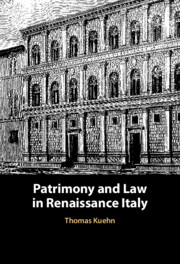Book contents
- Patrimony and Law in Renaissance Italy
- Patrimony and Law in Renaissance Italy
- Copyright page
- Contents
- Acknowledgments
- 1 Introduction
- 2 Bartolus and Family in Law
- 3 The Divisible Patrimony
- 4 Property of Spouses in Law in Renaissance Florence
- 5 Societas and Fraterna of Brothers
- 6 Fideicommissum and Law
- 7 Estate Inventories as Legal Instruments in Renaissance Italy
- 8 Prudence, Personhood, and Law in Renaissance Italy
- 9 Addendum
- 10 Conclusion
- Bibliography
- Index
3 - The Divisible Patrimony
Legal Property Relations of Fathers and Sons in Renaissance Florence
Published online by Cambridge University Press: 24 February 2022
- Patrimony and Law in Renaissance Italy
- Patrimony and Law in Renaissance Italy
- Copyright page
- Contents
- Acknowledgments
- 1 Introduction
- 2 Bartolus and Family in Law
- 3 The Divisible Patrimony
- 4 Property of Spouses in Law in Renaissance Florence
- 5 Societas and Fraterna of Brothers
- 6 Fideicommissum and Law
- 7 Estate Inventories as Legal Instruments in Renaissance Italy
- 8 Prudence, Personhood, and Law in Renaissance Italy
- 9 Addendum
- 10 Conclusion
- Bibliography
- Index
Summary
Humanists and moralists, such as Leon Battista Alberti, treated patrimony as a seamless whole, shared by all those in a household, but above all passed from father to son. Their vision is what Bartolus gave legal shape to. It is also substantiated in the fiscal statements heads of household submitted to the government of Florence to determine civic finances. But in fact in law there were subordinate and overlapping rights; sons could have property of their own, designated peculium in law, from several possible sources, including their own labors in the market economy outside the home. Presumed sharing of assets and liabilities by creditors sometimes vanished into devices that separated ownership, leading to real concerns with fraud. Family account books reveal careful maneuvering and accounting by fathers and sons. Sorting out what belonged to a son or whether a father was liable presented legal difficulties as well.
- Type
- Chapter
- Information
- Patrimony and Law in Renaissance Italy , pp. 42 - 72Publisher: Cambridge University PressPrint publication year: 2022

